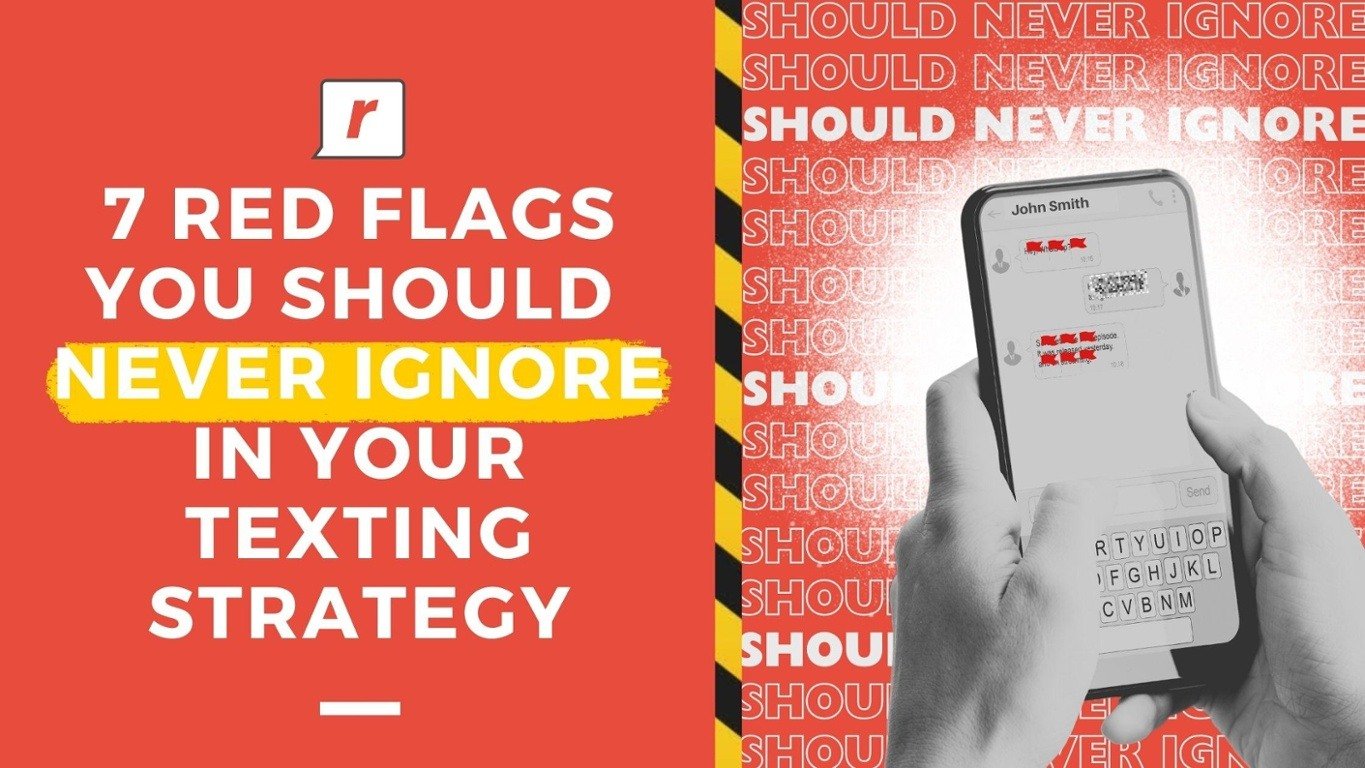7 Red Flags You Should Never Ignore in Your Texting Outreach Strategy

Avoid these common mistakes in your texting outreach. Learn how to personalize, target, and engage effectively for a winning campaign.
With so much riding on every text message you send in these final two weeks, it's essential to identify and avoid habits that could undermine your efforts. Practicing the “red flags” of texting not only reduces the effectiveness of your outreach but can also lead to wasted resources, frustrated recipients, and diminished trust.
It does not matter if you're managing a grassroots movement, a non-profit advocacy campaign, or a high-stakes political race - even the most well-intentioned texting campaigns can stumble due to these common but critical mistakes.
So, let’s jump right into it. Here are our 7 red flags to watch out for when managing your texting campaigns.
🚩 Lack of Personalization
Trends in political tech tend to follow the habits seen in standard B2B and B2C businesses. Notably, research has shown that 80% of consumers are more likely to make a purchase from a brand that offers personalized experiences. In political texting, this can mean the difference between a message that feels like a generic mass blast (that will be ignored) versus one genuinely tailored to the voter that drives them to donate, complete a survey, or go to the polls.
The negative effect of failing to practice personalization is one that political operatives have faced very prominently this year, especially in the fundraising space. The numbers support this negative effect: 63% of consumers will stop engaging with brands that fail to provide effective personalization. Let’s take a look at contrasting GOTV text examples to see this in action.

The red-flagged message is too generic and lacks credibility, as many will correctly assume it's just another mass text or even question its authenticity. Without providing relevant details, it feels impersonal, making it easy for recipients to ignore them.
In contrast, the green-flagged message feels more personalized and relevant, following best practices by clearly identifying the sender name and organization. It includes specific details like Election Day and the voter’s polling location, ensuring that even if there's a delay in the recipient message delivery, it doesn’t seem like the campaign is attempting to suppress votes. This targeted approach builds trust and keeps voters informed.
Don’t have the data needed for personalization? Well, there is good news; 83% of consumers are willing to share their data to create a more personalized experience. You heard that right - free, zero-party data.
For example - if a voter replies back to your text expressing concern about local advocacy issues, adding them to a new list and mentioning those specific topics in your subsequent texts to them demonstrates that you’re attentive to their interests, exponentially increasing the likelihood they will complete CTAs by making them feel heard and appreciated.
🚩 Failing to Target the Right Audience
Hinted at in that last example, blasting messages to your entire contact list without proper targeting and segmentation is the fastest way to turn voters off to your campaign.
Suppose you do not have enough zero-party data to work off of. In that case, we offer many data integrations to collect or append your data with behavioral, demographic, psychographic and geographic fields that make your texts more relevant to increase engagement with your audience.
Back to business proof - research shows that segmentation plays a vital role in marketing success. Companies that segment their audience obtained improved conversion rates. In fact, 91% of consumers are more likely to shop with brands that recognize and provide relevant offers based on their preferences. Expect the same reaction with voters.
Irrelevant texts are more prominent now that GOTV messaging is in full swing, but your campaign does not have to contribute to the problem. With our free AB/EV Data Sync Integration, you can easily clean and sync your data to ensure you are texting the right GOTV messages to voters.
🚩 Ignoring Opt-Outs
Not honoring opt-out requests can lead to more than just annoyed contacts; it can also bring serious legal consequences.
In texting, failure to comply with opt-out requests can also result in penalties for violating the Telephone Consumer Protection Act (TCPA). This law strictly mandates that once a person requests to opt out, all further text messages must cease.
Beyond legal risks, ignoring opt-outs can quickly turn into bad PR. If someone complains publicly about being spammed after opting out and it goes viral, you could cause permanent damage to your credibility.

We know how serious an issue opt-outs are, which is why we have a universal automatic opt-out system in place to both protect our clients and ensure that the end user experience is a positive one.
However, if you are working with a cut-rate vendor who disrespects opt-outs to make a quick extra buck, it will fall on you to always track opt-outs carefully and promptly remove anyone who has opted out from your contact list.
🚩 Overloading Recipients with Fundraising Texts

Text fundraising done well is a delicate art. Many fundraising professionals do not understand that sending too many messages in a short period will overwhelm recipients, leading to frustration and opt-outs, especially if they also ignore responses on top of this spamming behavior. The red-flagged message suffers from over-sending, being too generic and failing to remind recipients of the cause, making it borderline unbearable to receive.
Spacing out fundraising texts and including valuable, relevant information between messages is vital to maintaining voter engagement. In the green-flagged example, recipients receive clear details about the cause they’re supporting, which will help encourage them to donate in the final days.
Remember, in texting, finding the right balance is key.
🚩 Weak Call-to-Action (CTA)
Studies show that a well-crafted CTA can significantly boost engagement and conversions across all communication channels. For instance, clear CTAs in emails can increase clicks by up to 371%. The same principle applies to texting - a strong and direct CTA can drive higher response rates.

In this example, the red-flagged text is vague, lacking event details and a clear call to action (CTA). Including a CTA that directs recipients to a specific page rather than a generic website makes it easier for the message’s recipients to take the desired action. Whether you’re seeking donations or event attendance, the CTA should guide recipients to a simple, straightforward action.
The smoother you make the user journey, the more likely they will engage.
🚩 Not Tracking Metrics
Tracking key metrics like response, conversion and opt-out rates are essential to running a successful texting campaign. These insights are necessary to navigate texting with a clear sense of direction.
By measuring performance, you can uncover areas that need improvement and fine-tune your outreach for better results. Metrics such as deliverability and response rates are especially important, as they provide the data necessary to refine your strategy based on actual performance.
In fact, 72% of high-performing marketers report that data-driven decisions boost campaign success, which absolutely translates to marketing a campaign, advocacy initiative, etc. Utilizing data helps you pinpoint what’s working and what needs adjustment, ensuring your campaigns remain targeted and effective.

🚩 Ignoring Replies
If you're not actively encouraging replies in your texting campaigns, you're leaving valuable first-party data on the table that will allow you to fine-tune your strategy in real time.
Positive and neutral responses are not just numbers; they represent individuals who are open to your message. By engaging with these replies, you can convert tentative supporters into active advocates and adjust your messaging to clear up any confusion in the future. Personalized follow-ups will strengthen relationships and increase the likelihood of support in critical moments.
On the flip side, replies also help you identify contacts who may not be receptive (or are blatantly hostile) toward your outreach. Cleaning your lists of these contacts improves the efficiency of your campaigns by focusing resources where they're most effective.

Bottom Line
Stay alert to these red flags to ensure your P2P texting campaigns stay engaging and effective. We’re here to help you tackle any potential issues and optimize your outreach just in time for the final push before elections.
Ready to take action? Connect with our team or visit our website at rumbleup.com.
Winners Rumble🥊
Explore Industry Insights:
Explore Thomas Peters' Q&A for insights to navigate the final stretch of campaign season - Doomscroll

![i360 vs. RumbleUp Which platform is best for your campaign [2025]](https://rumbleup.com/hubfs/i360%20vs.%20RumbleUp%20Which%20platform%20is%20best%20for%20your%20campaign%20%5B2025%5D.png)
![Hustle vs. RumbleUp Which Peer-to-Peer Texting Platform is Right for You [2025]](https://rumbleup.com/hubfs/Hustle%20vs.%20RumbleUp%20Which%20Peer-to-Peer%20Texting%20Platform%20is%20Right%20for%20You%202025.png)